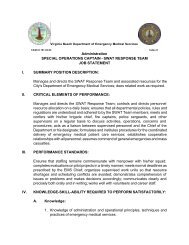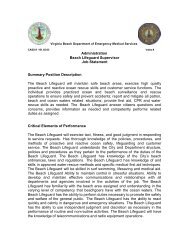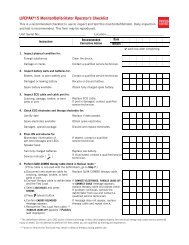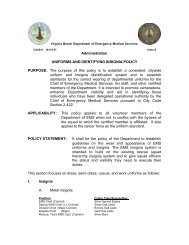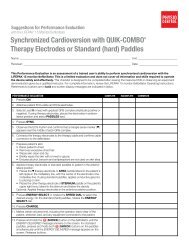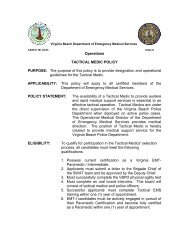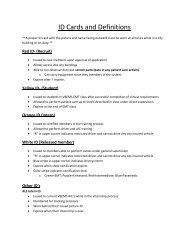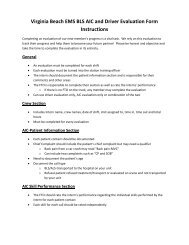2009 RSI & Difficult Airway Review for website.ppt ... - Vbems.com
2009 RSI & Difficult Airway Review for website.ppt ... - Vbems.com
2009 RSI & Difficult Airway Review for website.ppt ... - Vbems.com
Create successful ePaper yourself
Turn your PDF publications into a flip-book with our unique Google optimized e-Paper software.
<strong>RSI</strong> & <strong>Difficult</strong> <strong>Airway</strong> <strong>Review</strong>
<strong>RSI</strong> Considerations<br />
? Rapid Sequence Induction (<strong>RSI</strong>)<br />
should be considered in all patients<br />
requiring emergency intubation<br />
except those who are:<br />
• In cardiac arrest<br />
• Deeply <strong>com</strong>atose
? 1. Assess the risks<br />
? 2. Get equipment<br />
ready<br />
? 3. Monitor the<br />
patient<br />
? 4. Pre-oxygenate<br />
the patient<br />
? 5. Medicate the<br />
patient<br />
TEMS <strong>RSI</strong><br />
10 steps
TEMS <strong>RSI</strong><br />
10 steps<br />
? 6. Sedation and<br />
Paralysis<br />
? 7. Sellick’s<br />
Maneuver<br />
? 8. Intubate the<br />
patient<br />
? 9. Verify placement<br />
? 10.Secure the<br />
endotracheal tube
ASSESS THE RISKS<br />
DIFFICULT AIRWAY:<br />
<strong>Difficult</strong> to mask ventilate<br />
<strong>Difficult</strong> to intubate
Complexity<br />
The difficult airway represents a<br />
<strong>com</strong>plex interaction between<br />
patient factors, the<br />
prehospital/clinical setting, and<br />
the skills of the EMS provider.
<strong>Difficult</strong> <strong>Airway</strong> Characteristics<br />
? Beard<br />
? No Teeth<br />
? Large Tongue<br />
? Small mouth opening<br />
? Protruding upper teeth<br />
? Recessed lower jaw<br />
? Head size/shape<br />
? Arthritis
<strong>Difficult</strong> <strong>Airway</strong> Characteristics<br />
? Spinal Curvature<br />
? Tumors<br />
? Infections<br />
? Trauma<br />
? Obesity<br />
? Previous <strong>Airway</strong> Surgery<br />
? Congenital problems<br />
? Pregnancy
Equipment to have ready<br />
includes:<br />
? An appropriate sized BVM with<br />
reservoir<br />
? A hooked up and operational suction<br />
unit with tonsil tip device<br />
? Oxygen hooked to BVM
Equipment to have ready<br />
includes:<br />
? Laryngoscope with<br />
blade and working<br />
light<br />
? Stylet <strong>for</strong> ETT<br />
? Stethoscope<br />
? Medications<br />
? Secondary <strong>Airway</strong><br />
Devices
Secondary <strong>Airway</strong> Devices<br />
? Combitube<br />
? LMA<br />
? King <strong>Airway</strong>
Personnel Needed:<br />
? Minimum of 4 people<br />
• <strong>RSI</strong> Paramedic<br />
• Second ALS provider<br />
<strong>for</strong> airway<br />
• EMS provider <strong>for</strong><br />
Sellick’s maneuver<br />
• Provider <strong>for</strong> ancillary<br />
tasks
Monitoring the Patient<br />
? Prior to using<br />
<strong>RSI</strong>, the patient<br />
will have<br />
• Heart monitoring<br />
• Pulse Oximetry<br />
• Complete set of<br />
vital signs
Pre-Oxygenation<br />
? When a patient is paralyzed, all<br />
respiratory ef<strong>for</strong>t will cease <strong>for</strong> as<br />
long as the paralytic remains<br />
effective.<br />
? Place all patients on 100% Oxygen<br />
as soon as decision is made to<br />
intubate (if not be<strong>for</strong>e).
Bag and Mask Ventilation<br />
? Generally speaking, a BVM should<br />
only be used to assist natural<br />
ventilations.<br />
? Over aggressive BVM ventilation can<br />
lead to gastric distension and<br />
vomiting.
Bag and Mask Ventilation<br />
? If it is necessary to<br />
use BVM ventilations<br />
to pre-oxygenate the<br />
patient, the Sellick’s<br />
maneuver should be<br />
used to prevent<br />
gastric distension.<br />
? Maintain this<br />
throughout the<br />
procedure<br />
Sellick’s Maneuver
Patient Packaging<br />
? All patients who are candidates <strong>for</strong><br />
rapid sequence induction should be<br />
packaged <strong>for</strong> transport prior to the<br />
induction
Medicating the Patient<br />
• Atropine<br />
? Blocks vagal stimulation associated with<br />
prolonged intubation<br />
? Given to<br />
• All pediatric patients<br />
• Adults who are bradycardic<br />
• Lidocaine<br />
? Lidocaine is to be given to patients with suspected<br />
increases in intracranial pressure.<br />
? Lidocaine is thought to blunt rises in intracranial<br />
pressure seen during intubation attempts
Sedation and Paralysis<br />
? In the TEMS region, the sedative of<br />
choice <strong>for</strong> induction is Etomidate with<br />
Succinylcholine as the paralytic<br />
agent of choice.
Warning!<br />
? Paralysis is a frightening event <strong>for</strong><br />
the patient and should always be<br />
preceded by the administration of a<br />
sedative agent, such as Etomidate.
Sedation and Paralysis<br />
? Midazolam (Versed)<br />
– alternative<br />
sedative<br />
? Vecuronium<br />
(norcuron) –<br />
alternative paralytic
Intubation of Patient<br />
? Don’t <strong>for</strong>get the<br />
Sellick’s Maneuver
Intubation of the Patient<br />
? Intubation is<br />
per<strong>for</strong>med after<br />
paralysis of the<br />
body has taken<br />
place<br />
• 45-60 seconds<br />
following<br />
Succinycholine<br />
administration<br />
• jaw relaxes<br />
? Per<strong>for</strong>med by I/P<br />
proficient in skill
Intubation of the Patient<br />
? If intubation<br />
attempt fails,<br />
Sellick’s maneuver<br />
(cricoid pressure)<br />
should be<br />
maintained during<br />
bag and mask<br />
ventilations until<br />
an ETT is placed or<br />
a secondary airway<br />
device is used
Intubation of the Patient<br />
? If the initial attempt at intubation<br />
is unsuccessful, remove the blade<br />
and ventilate the patient with bag<br />
and mask ventilation <strong>for</strong> 60 to 90<br />
seconds<br />
? 3 attempts by 2 providers
Secondary <strong>Airway</strong> Devices<br />
? Approved<br />
secondary airway<br />
devices in the<br />
TEMS region are:<br />
• Laryngeal Mask<br />
<strong>Airway</strong><br />
• Combitube<br />
• King <strong>Airway</strong>
Cricothyrotomy<br />
? Emergency<br />
<strong>Airway</strong><br />
? Consider if<br />
• Combitube<br />
insertion is<br />
unsuccessful AND<br />
• BLS maneuvers<br />
are unsuccessful<br />
• Special situations<br />
(i.e. respiratory<br />
burns)
Verify Placement<br />
? Once intubated,<br />
tube placement is<br />
to be confirmed<br />
with:<br />
• Auscultation<br />
• End Tidal CO2<br />
? Reassess<br />
• Vitals<br />
• Pulse oximetry
Endotracheal Tube Placement<br />
? Confirmation of tube placement is<br />
more important than the intubation<br />
itself!
Reassessment<br />
? Patient monitoring<br />
is to continue at 5<br />
minute intervals<br />
with tube<br />
reconfirmation<br />
after each patient<br />
movement.
Secure the Tube<br />
? A <strong>com</strong>mercial tube holder is<br />
re<strong>com</strong>mended
Secure The Tube<br />
? Sedation will be needed to ensure<br />
that the tube remains secure<br />
during transport<br />
? All patients intubated using <strong>RSI</strong>,<br />
are to be sedated <strong>for</strong> the transport<br />
to the hospital
Transportation of the Sedated<br />
and Paralyzed Patient<br />
? Versed is used <strong>for</strong> post-<br />
intubation sedation in<br />
the TEMS region<br />
? Vecuronium is used <strong>for</strong><br />
maintenance of paralysis<br />
? Additional security is<br />
provided by placing<br />
paralyzed patient in full<br />
spinal immobilization
Transportation of the Sedated<br />
and Paralyzed Patient<br />
? The risk of<br />
extubation is<br />
higher in small<br />
children and<br />
infants<br />
? Be Careful!!!
Critical Criteria <strong>Review</strong><br />
? Ensure that all<br />
equipment<br />
necessary <strong>for</strong> <strong>RSI</strong><br />
is assembled and<br />
ready <strong>for</strong> use.<br />
? This includes<br />
readiness of a<br />
secondary or<br />
alternative airway<br />
device.
Critical Criteria <strong>Review</strong><br />
? The goal <strong>for</strong> the<br />
paramedic<br />
engaged in a<br />
rapid sequence<br />
induction event is<br />
the successful<br />
<strong>com</strong>pletion of the<br />
event.<br />
? Intubation is only<br />
one aspect of the<br />
event. The <strong>RSI</strong><br />
event is<br />
successful if the<br />
patient is properly<br />
ventilated with a<br />
<strong>com</strong>bi-tube or<br />
BLS airway.



